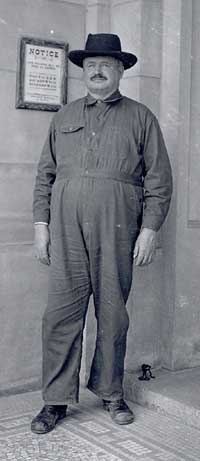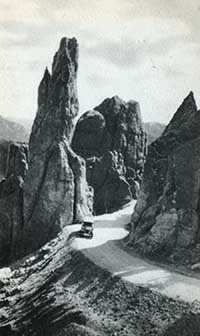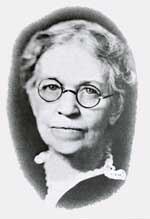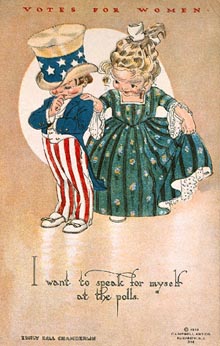|
Lesson 2
Peter Norbeck and Mary Shields Pyle
|
| |
At first, the
people who governed the state of South Dakota were from other places.
They came to the state as adults. They were homesteaders or town
builders. After 1900, people who grew up in the area took over the task
of governing. These leaders helped the state find its own identity.
|
|
TIMELINE |
|
|
1904 |
| Rosebud Reservation lands
open |
|
1917 |
| America enters First World
War |
|
1918 |
| South Dakota women get the
vote |
|
1919 |
| Custer State Park set up |
| First film made by an
African American |
|
1920 |
| Nineteenth Amendment
passes |
| Radio broadcasting begins |
|
1927 |
| President Coolidge visits
Black Hills |
|
1931 |
| Great Depression begins |
|
1933 |
| New Deal programs begin |
|
1939 |
| Second World War begins |
|
1944 |
| Missouri River dam
projects begin |
|
Peter Norbeck
Peter Norbeck
was the first
governor to be
born in Dakota. He was also the first United States senator from
South Dakota to be
born here. As a young man, he helped to solve water problems. As
governor and senator, he built parks and roads. His work left a
special heritage for South Dakota.

Photo courtesy of South Dakota State
Historical Society
|
|
|
Norbeck was
born in a
dugout in southeastern
Dakota Territory. The year was 1870. Later his family moved west of
the Missouri River. They homesteaded in Charles Mix County. Here he
learned that low rainfall made farming hard. Wells were needed to
water the crops and the livestock. Most wells in South Dakota were artesian
wells. They were very deep. It cost a lot of money to drill
them. Norbeck found a way to drill wells that cost less money. Soon
he was drilling wells all across South Dakota.
Norbeck
set up his business in Redfield in Spink County. Voters elected
him to the state senate in 1908. Later the people of South
Dakota elected him governor. He tried different ways to solve
problems for citizens. He set up state hail insurance for
farmers. He started a coal mine and a cement plant. He helped to
set up Custer State Park. Today, his work with parks is what we
remember most.
|
|

Photo courtesy of South Dakota State
Historical Society
|
In 1920,
Norbeck won a seat in the United States Senate. From there, he
worked to get scenic roads built in the Black Hills. Soon Needles
Highway and Iron Mountain Road were built. Norbeck also found
money for other parks and memorials. Norbeck died in 1936.
|
|
|
|
|
Mary Shields Pyle
|
From 1904 to
1915, many single women took claims in South Dakota. Married women
still worked mostly in the home. Neither could vote, but many women
wanted to vote. Then the First World War sent South Dakota men to the
battlefield. Women took more roles outside the home. They soon
wanted more rights.
|
|

Photo courtesy of South Dakota State
Historical Society
|
Mary ("Mamie")
Shields was born in 1866. She moved to Dakota Territory as a young
girl. She worked as a schoolteacher in Brookings and Hand counties.
She married John L. Pyle and later moved to Huron. After her husband
died in 1902, Mary Pyle had little money. She also had four children
she had to feed. She took over her husbandís work. She ran his
business. She was active in
civic
affairs. She served on the Board of Trustees for Huron College. She
was active in the local Red Cross.
|
|
Votes for women
seemed only right to someone like Mary Pyle. She worked to change
the law that said only men could vote. Pyle was a good public
speaker. Soon she was president of the State Woman Suffrage
Association. She talked to people all across the state. She
wrote about woman
suffrage for
the newspapers. In 1918, South Dakota women won the right to vote.
They could vote in state elections. Two years later, women across
the United States gained the vote. This was done through the Nineteenth
Amendment to the United States Constitution. Pyle helped make
South Dakota one of the first states to
ratify
the
amendment.
|

Photo courtesy of South Dakota State
Historical Society
|
|
|
The right to
vote was important to Pyle. It made women full citizens. Now they
could run for public office. Pyle died in 1949. Her daughter, Gladys
Pyle, followed in her motherís footsteps. Gladys Pyle served as a state legislator and United States senator. She used the rights her
mother had won.
|
| Vocabulary |
|
| amendment (n.), a revision or change
civic (adj.), belonging to a city
dugout (n.), a hole dug into a hillside used as a
house
|
governor (n.), the head of a state
ratify (v.), to approve
suffrage (n.), the right to vote
|
|